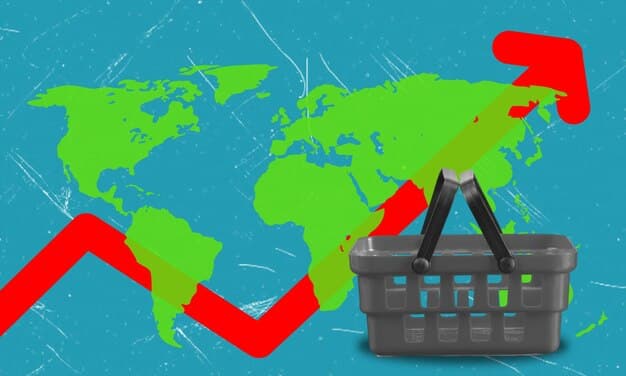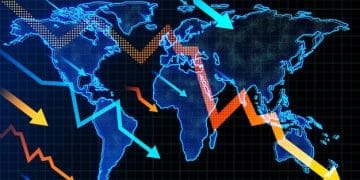Dollar’s 3% Appreciation: Analyzing Its Global Market Impact

The US dollar’s 3% appreciation on international markets triggers a cascade of effects, influencing trade balances, commodity prices, debt burdens, and investment flows across diverse economies, reshaping global financial dynamics.
The global economy is an intricate web of interconnected dynamics, where even minor shifts in one major player can send ripples worldwide. When considering the US dollar’s 3% appreciation on international markets, it is crucial to recognize that this seemingly modest movement can precipitate significant economic adjustments across continents. Such an appreciation is not merely a numerical fluctuation; it represents a tangible shift in economic power and can profoundly influence trade, investment, and policy decisions for nations far and wide.
understanding currency appreciation and its roots
Currency appreciation refers to an increase in the value of one currency in relation to another. In the context of the US dollar, a 3% appreciation means that the dollar can now buy more goods, services, or financial assets denominated in foreign currencies than it could before. This shift is not arbitrary; it is typically driven by a combination of economic fundamentals and market sentiment.
Several factors can contribute to such an appreciation. Interest rate differentials, for instance, play a significant role. If the Federal Reserve raises interest rates or signals a hawkish monetary policy, it makes dollar-denominated assets, such as government bonds, more attractive to foreign investors seeking higher returns. This increased demand for dollar assets consequently drives up the dollar’s value. Similarly, strong economic growth within the United States, indicating robust consumer spending, low unemployment, and rising corporate profits, can attract foreign investment. A perception of economic stability and a favorable investment climate can lead to capital inflows, strengthening the dollar.
economic indicators and policy decisions
Investor confidence is another critical component. In times of global economic uncertainty or geopolitical instability, the US dollar often acts as a safe-haven asset. Investors tend to flock to the perceived security of the dollar, US Treasuries, and other dollar-denominated assets, driving up its value. This flight to safety can occur even if the US economy itself is facing challenges, as long as it is seen as relatively more stable than other major economies.
- Interest Rate Hikes: Higher rates in the US compared to other major economies attract foreign capital seeking better returns.
- Strong Economic Performance: Robust GDP growth, low unemployment, and a healthy job market signal a strong investment environment.
- Safe-Haven Status: During global crises, the dollar is often seen as a secure store of value, drawing in capital.
- Fiscal Health & Policy: Prudent fiscal policies and clear monetary guidance from the Federal Reserve bolster investor confidence.
Furthermore, government policies, including trade agreements, fiscal measures (like tax cuts or stimulus packages), and regulatory changes, can influence capital flows and investor sentiment directly. A government’s commitment to fiscal discipline or a move towards more business-friendly policies can make a country’s currency more appealing. The complex interplay of these factors means that a 3% appreciation of the dollar, while seemingly small, is rarely an isolated event. It often reflects deeper economic trends or significant policy shifts that warrant careful consideration from a global perspective.
Understanding these underlying causes is fundamental to analyzing the broader economic impacts. Without grasping why the dollar has appreciated, it becomes challenging to accurately predict or assess the subsequent chain reactions throughout international markets. This foundational knowledge allows for a more nuanced interpretation of both the immediate and long-term consequences, framing the discussion around a specific event within a broader economic context.
impact on global trade and commodity prices
The appreciation of the US dollar has significant ramifications for global trade patterns and the pricing of commodities, given that many international transactions and raw materials are denominated in dollars. For countries that import goods from the US, a stronger dollar makes those imports more expensive in their local currencies. This can lead to higher import bills, contributing to inflationary pressures and potentially reducing import volumes as consumers and businesses face increased costs.
Conversely, US exports become less competitive in international markets. A stronger dollar means that foreign buyers need to spend more of their local currency to purchase American goods and services. This can dampen demand for US exports, potentially harming American businesses that rely on international sales and contributing to a widening trade deficit. The balance between imports and exports is crucial for a nation’s economic health, and a significant shift in currency value can disrupt this equilibrium.
commodity market dynamics
The commodity markets are particularly sensitive to dollar fluctuations. Oil, gold, copper, and many agricultural products are priced in US dollars. When the dollar appreciates, it means that for non-dollar denominated buyers, these commodities effectively become more expensive. This can lead to a decrease in demand for these commodities, as purchasing power is diminished, potentially pushing down their prices in dollar terms while increasing their cost in local currencies.
- Oil Prices: A stronger dollar can make oil more expensive for non-dollar users, potentially lowering global demand.
- Gold & Precious Metals: Often seen as an alternative to the dollar, a stronger dollar can reduce gold’s appeal as a safe-haven, impacting its price.
- Agricultural Products: Farmers in non-US countries might face higher input costs (e.g., dollar-denominated fertilizers) and reduced export competitiveness.
- Industrial Metals: Increased cost for international buyers could slow down industrial activity in some regions.
This dynamic has a dual effect: it can provide some relief to US consumers regarding imported goods, making them cheaper, but it also means that US companies exporting goods face tougher competition. For countries whose economies heavily rely on commodity exports, a stronger dollar can be detrimental. They might see the real value of their exports decrease, impacting their revenues and economic stability. For example, a nation exporting oil that is priced in dollars receives less real value for its exports when the dollar strengthens, assuming the dollar price of oil doesn’t rise commensurately.
Moreover, the expectation of a stronger dollar can influence investor behavior in commodity markets, leading to speculative movements that further amplify price changes. This interconnectedness means that even a 3% appreciation of the dollar creates a complex web of winners and losers across the global trade landscape and within vital commodity sectors.
implications for emerging markets and developing economies
Emerging markets and developing economies (EMDEs) are particularly vulnerable to a strengthening US dollar. Many of these economies have significant portions of their sovereign and corporate debt denominated in dollars. When the dollar appreciates, the cost of servicing this debt in local currency terms increases substantially. This can strain government budgets, diverting funds from essential public services and infrastructure projects towards debt repayment.
Businesses in EMDEs that rely on dollar-denominated imports or have dollar-denominated loans also face higher costs. This can reduce profitability, hinder expansion, and even lead to financial distress, potentially triggering a wave of corporate defaults. The currency mismatch between revenues (often domestic currency) and liabilities (US dollars) creates a significant point of vulnerability.
capital flows and investment sentiment
Furthermore, a stronger dollar can trigger capital outflows from EMDEs. As dollar-denominated assets become more attractive due to higher expected returns or perceived safety, international investors may shift their funds out of emerging markets. This “flight to quality” can weaken the local currencies of EMDEs, exacerbate inflationary pressures, and make it even more challenging for these economies to attract foreign direct investment necessary for growth and development.
- Increased Debt Burden: Dollar-denominated debt becomes more expensive to service in local currency.
- Capital Outflows: Investors move funds to safer, higher-yielding dollar assets.
- Reduced Investment: Higher borrowing costs and less attractive local currencies deter new foreign direct investment.
- Inflationary Pressures: Higher import costs due to a weaker local currency can fuel inflation.
Central banks in EMDEs often face a difficult dilemma: raise interest rates to defend their currency and stem capital outflows, thereby risking a slowdown in domestic economic growth, or allow their currency to devalue further, which could worsen inflation and debt burdens. The policy choices available are often limited and fraught with difficult trade-offs.
The long-term implications can be severe, potentially undermining years of economic progress and stability. A persistent appreciation of the dollar can stifle economic growth by making exports less competitive, increasing the cost of essential imports, and reducing foreign investment. This dynamic also highlights the interconnectedness of global finance, where monetary policy decisions in advanced economies, particularly the United States, have profound and often disproportionate effects on the rest of the world.
impact on developed economies and financial markets

While emerging markets often bear the brunt of a strengthening dollar, developed economies are by no means immune to its effects. For instance, European countries and Japan, which are major trading partners with the US, experience similar challenges regarding export competitiveness. A stronger dollar makes their exports to the US relatively cheaper for American consumers, which could boost their export volumes. However, it also makes their imports from the US more expensive, impacting domestic inflation and potentially leading to higher input costs for their industries.
Moreover, a stronger dollar can create headwinds for multinational corporations based in other developed nations. Their dollar-denominated earnings, when converted back into their local currencies, will be worth less, potentially impacting their reported profits and stock performance. This currency translation effect can be significant, especially for companies with substantial operations or sales in the US market.
monetary policy challenges for central banks
Central banks in developed economies may also face complex monetary policy decisions. If a stronger dollar leads to a weakening of their domestic currencies, it can contribute to imported inflation. This might prompt their central banks to consider raising interest rates to combat inflation, even if their domestic economic conditions do not otherwise warrant such a tightening. This creates a delicate balancing act, as too aggressive a rate hike could stifle economic growth.
- Export Competitiveness: Non-US developed nations might see their exports to the US become more competitive but face higher import costs.
- Multinational Earnings: Companies with significant dollar-denominated earnings face negative currency translation effects when converting profits to home currency.
- Central Bank Dilemmas: Pressure to raise rates to combat imported inflation, potentially risking domestic growth.
- Investment Portfolio Shifts: Revaluation of international assets and liabilities for investors with diverse portfolios.
Financial markets within developed economies also react to a stronger dollar. Bond markets might see shifts as investors reallocate portfolios based on perceived interest rate differentials and sovereign debt attractiveness. Equity markets could experience volatility as corporate earnings are re-evaluated and sector-specific impacts become clear. For example, technology companies with global supply chains might face higher costs for dollar-denominated components, while companies with substantial US dollar revenue streams could see a boost if their reporting currency is not the dollar.
The interconnectedness of global financial systems means that a significant movement in the world’s primary reserve currency reverberates through equity, bond, and derivative markets. Investors and policymakers in developed nations must carefully monitor these dynamics, adapting their strategies and policies to navigate what can be a challenging and unpredictable financial landscape.
sector-specific analysis: winners and losers
A 3% appreciation of the US dollar does not impact all sectors of the global economy equally. There are clearly identifiable winners and losers, depending on their exposure to international trade, commodity prices, and dollar-denominated financing. Understanding these nuances is crucial for both businesses strategizing for the future and investors seeking to optimize their portfolios.
US companies engaged primarily in domestic sales and using domestically sourced inputs may see minimal direct impact, or even benefit from cheaper imported components. However, US exporters will face tougher conditions, as their goods become more expensive for foreign buyers. This could particularly affect sectors such as machinery, agricultural products, and high-tech manufacturing, where international sales are a significant revenue driver.
global impacts across industries
Conversely, foreign companies that export significantly to the US market could see a boost in their competitiveness. German luxury car manufacturers, Japanese electronics firms, or Brazilian agricultural producers exporting to the US might find their products more attractive to American consumers due to the favorable exchange rate. This could lead to increased sales volumes, although their revenue in dollar terms would translate to fewer units of their home currency.
- US Exporters: Face reduced competitiveness and potentially lower sales volumes abroad.
- Foreign Exporters to US: Benefit from increased competitiveness and potentially higher demand from American consumers.
- Commodity Importers (non-US): Experience higher costs for dollar-denominated raw materials, impacting production expenses.
- Airlines & Shipping: May face higher fuel costs (oil is dollar-denominated) but potentially benefit from diverse revenue streams.
For sectors heavily reliant on dollar-denominated commodities, such as manufacturing and transportation, the impact is often negative, particularly outside the US. An airline in Europe, for example, will see its fuel costs, priced in dollars, rise when translated to Euros. This increases operational expenses, which may then be passed on to consumers in the form of higher fares, or absorbed, impacting profitability. Similarly, manufacturing firms that import raw materials like metals or energy from dollar-denominated markets will face escalating input costs, potentially squeezing profit margins.
The financial services sector, too, experiences diverse impacts. Banks with significant international lending in dollars will find their foreign currency-denominated assets appreciating, potentially improving their balance sheets. However, those with large exposures to dollar-denominated liabilities in non-US currencies might face increased repayment burdens. Investment firms also need to re-evaluate international portfolios, adjusting for currency fluctuations that can significantly alter the returns on foreign assets.
In essence, the dollar’s appreciation acts as a pivot, rebalancing competitive advantages and cost structures across industries globally. The key is adaptation: sectors and businesses that can swiftly adjust their supply chains, pricing strategies, and hedging mechanisms will be better positioned to navigate the ripple effects of a stronger dollar.
policy responses and risk mitigation strategies
In response to a significant dollar appreciation, governments and central banks worldwide often implement various policy adjustments to mitigate adverse effects. These strategies aim to stabilize their economies, support local industries, and manage debt burdens. For instance, central banks in countries experiencing capital outflows and currency depreciation might consider tightening monetary policy by raising interest rates. While this can help stem outflows and support the local currency, it also carries the risk of slowing down domestic economic activity.
Fiscal policy can also play a role. Governments might implement targeted measures to support export-oriented industries or provide assistance to sectors heavily reliant on dollar-denominated imports. This could involve subsidies, tax breaks, or other forms of financial relief. However, such measures must be carefully managed to avoid distorting markets or accumulating excessive public debt.
corporate and investor strategies
From a corporate perspective, businesses exposed to currency fluctuations employ various risk mitigation strategies. Hedging, through instruments like forward contracts, options, or currency swaps, allows companies to lock in exchange rates for future transactions, providing certainty and protecting against adverse movements. Diversifying supply chains and sales markets can also reduce reliance on any single currency or economy.
- Central Bank Interventions: Could raise interest rates to protect local currency, or directly intervene in FX markets.
- Fiscal Measures: Governments may offer subsidies or tax incentives to affected industries.
- Currency Hedging: Businesses use financial instruments to lock in exchange rates for future transactions.
- Diversification: Companies spread operations and markets to reduce reliance on specific currencies or economies.
For investors, a strong dollar necessitates a reassessment of international portfolios. Investors holding assets in non-dollar currencies might consider increasing their dollar-denominated holdings to benefit from further appreciation or to offset potential losses in other currencies. Diversification across different currencies and asset classes becomes even more critical. Investors might also look for opportunities in US-based companies with predominantly domestic revenue streams, as these would be less impacted by currency translation effects.
Furthermore, enhancing economic resilience through structural reforms is a long-term strategy for many EMDEs. This includes building larger foreign exchange reserves, reducing reliance on dollar-denominated debt, and fostering diversified export bases. These reforms, while taking time to implement, can significantly bolster a country’s ability to withstand external shocks, including substantial currency movements.
Ultimately, a coordinated approach involving monetary policy, fiscal measures, and corporate hedging strategies is often necessary to effectively navigate the complexities introduced by a strengthening global reserve currency. Proactive planning and adaptable responses are key for both national economies and individual enterprises in managing currency volatility.
long-term outlook and global economic rebalancing
The implications of a 3% dollar appreciation extend beyond immediate term effects, contributing to a broader rebalancing within the global economic landscape. While short-term impacts can be disruptive, persistent dollar strength can accelerate shifts in manufacturing, trade flows, and foreign investment patterns over time. Nations that consistently find their currencies weaker against a strong dollar may intensify efforts to diversify their economies, seeking to reduce reliance on dollar-denominated trade and finance.
This long-term outlook might see a push towards greater regional trade blocs, reducing dependency on distant markets and fostering intra-regional commerce. Furthermore, some countries might actively pursue the internationalization of their own currencies, aiming to reduce the dollar’s dominance in global transactions. While challenging, every instance of significant dollar strength provides an impetus for such long-term strategic realignments.
shifting global financial dynamics
Over time, sustained dollar appreciation could also influence global inflation dynamics. While it can temper inflation within the US by making imports cheaper, it can export inflation to other nations that rely heavily on dollar-denominated imports. This could prompt different monetary policy responses across the globe, leading to a more diversified and potentially fragmented global interest rate environment.
- Diversification of Global Trade: Nations may seek to reduce reliance on dollar-denominated transactions.
- Emergence of Regional Blocs: Increased focus on intra-regional trade to minimize currency exposure.
- Currency Internationalization: Other nations may push for their currencies to gain greater global acceptance.
- Inflationary Rebalancing: Dollar strength could exert different inflationary pressures across economies.
Investment patterns may also undergo a structural shift. As the cost of US assets increases for foreign investors due to currency appreciation, they might seek opportunities in alternative markets that offer more attractive currency-adjusted returns. This could lead to increased foreign direct investment in emerging markets or other developed economies where investment opportunities are perceived as more favorable given the exchange rate dynamics.
Ultimately, a strong dollar, even one appreciating by a seemingly modest 3%, reinforces its status as a critical actor in global finance. It serves as a constant reminder of the interconnectedness of economies and the need for nations and businesses alike to maintain flexible strategies. The ability to adapt to such shifts, rather than resist them, will define economic resilience in an increasingly volatile world. This ongoing rebalancing is a testament to the dynamic nature of international finance, where perpetual adjustment is the norm.
| Key Impact Area | Brief Description |
|---|---|
| 📊 Global Trade | US exports become more expensive, foreign imports to US cheaper. |
| 💰 Debt Burden (EMDEs) | Dollar-denominated debt costs more to service for emerging markets. |
| ⛽ Commodity Prices | Commodities (e.g., oil) become more expensive for non-dollar buyers. |
| 💸 Capital Flows | Attracts capital to US assets, potentially leading to outflows from other markets. |
frequently asked questions about dollar appreciation
The US dollar typically appreciates due to factors like higher interest rates relative to other countries, strong economic growth attracting foreign investment, or its role as a “safe-haven” currency during global uncertainty, driving higher demand for dollar-denominated assets and increasing its value.
For US consumers, a stronger dollar generally means imported goods and foreign travel become cheaper. Their purchasing power abroad increases, and products manufactured overseas and sold in the US may see price reductions. However, it can also lead to fewer job opportunities in export-oriented sectors.
Emerging markets are vulnerable because much of their government and corporate debt is denominated in US dollars. A stronger dollar makes these debt repayments more expensive in local currency, increasing the risk of default and straining national budgets and company finances, leading to potential instability.
Since many major commodities like oil and gold are priced in US dollars, a dollar appreciation makes them effectively more expensive for buyers using other currencies. This can lead to decreased global demand for these commodities, potentially exerting downward pressure on their dollar prices while increasing their cost in local currency terms.
Yes, countries can employ strategies such as raising domestic interest rates to support their currency, implementing fiscal policies to support affected industries, and encouraging businesses to use currency hedging. Long-term strategies involve reducing dollar-denominated debt and diversifying economic bases to build resilience.
conclusion
The US dollar’s 3% appreciation on international markets, while numerically small, represents a powerful force capable of reshaping global economic dynamics. From influencing trade balances and commodity prices to placing significant pressure on emerging market debt and prompting shifts in investment flows, its ripple effects are undeniable. As the world’s primary reserve currency, the dollar’s movements serve as a critical barometer for global financial health and interconnectedness. Understanding these intricate relationships is not merely an academic exercise; it is essential for policymakers, businesses, and investors seeking to navigate the complex and ever-evolving landscape of international economics. The ability to adapt to these shifts, through informed policy responses and strategic risk mitigation, remains paramount in ensuring economic stability and fostering sustainable growth worldwide.





